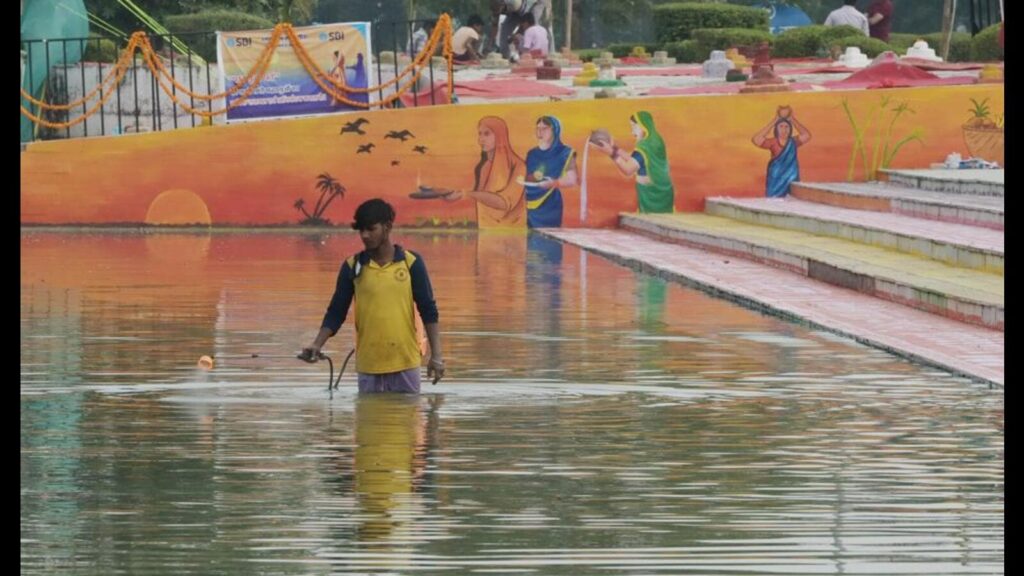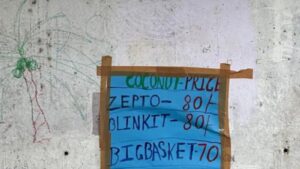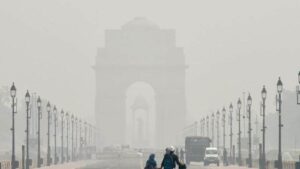Chhath Puja: Gomti undergoes chemical treatment for ‘quick cleansing’

LUCKNOW From chemical cure, flushing of dirty water from Gomti barrage, weed removal and mixing of chlorine to use of nets to keep pollutants at bay, authorities pulled out all stops to clean the Gomti on Thursday before thousands of devotees gathered at ghats for the holy dip. Hindustan Times had raised the issue of ‘ river water unfit for bathing’ in its edition on Thursday.

In a first, poly aluminium chloride (PAC), a chemical with coagulation property, was used to keep the water clean for Chhath Puja. Authorities said its success in keeping surface water clean for devotees will pave way for extensive use in the future.
The activity started in the wee hours as officials took stock of major ghats in the city and applied every possible mechanism to keep the water clean. The Lakshman Mela ground remained in focus as chief minister Yogi Adityanath, deputy chief minister Brajesh Pathak and many VIPs visited the place to perform rituals.
LMC zonal in-charge Amarjeet Singh, who has been overseeing Chhath preparations, completed his inspection by 7am. A fleet of officials from Lucknow Municipal Corporation (LMC), district administration, water works (Jalkal) department and Lucknow Development Authority (LDA) also came to the site to check what was required for ensuring better surface water quality, which a day before, was stated to be in ‘E’ category, unfit for bathing.
Surface water quality is categorized from A to E, where till category C, water can be consumed after conventional treatment. Water of category D is for propagation of wildlife and fish culture. Category E water is used for irrigation, industrial cooling and controlled waste disposal.
As four days of flushing from the Gomti barrage by the irrigation department did not help much, authorities resorted to chemical spray hours before the prayers started. The first round of PAC spray was done in the morning and repeated later. Sodium hypochlorite was also used at key ghats, including Jhulelal Ghat, Lakshman Mela Sthal, and Kudia Ghat.
“PAC plays an important role in aquaculture. It can quickly improve water quality and dissolved oxygen level as a side-effect of its coagulation property. PAC destabilises fine colloidal suspensions and causes them to clump together into large conglomerations,” said PK Srivastava, former scientist, Central Drug Research Institute. PAC is known to cause skin problems, if a person is subjected to prolonged exposure.
“This water treatment is a one of its kind and used only at the Lakshman Mela Ghat for the festival,” said water works department general manager Kuldeep Singh. Authorities said they were aware about the side-effects of PAC.
“We are assessing the results from this usage. If everything goes as per plan, we will use it in future events, when we need to clean water quickly,” he said.
“We are applying PAC in controlled doses to gauge its impact on water clarity and quality.” Singh explained that PAC comes in powder, liquid, and solid forms. Jalkal selected the liquid form for precise doses, added Singh.
“Past experiences show that such treatments are effective in improving water quality. We are confident that by the time Chhath festival celebrations begin, Gomti water will be much safer for devotees,” said municipal commissioner Inderjit Singh, earlier in the day.
An official from the Uttar Pradesh Pollution Control Board (UPPCB) confirmed that the treatment methods will have positive effect.
“The settling of contaminants is a good sign. If the dissolved oxygen content in the water reaches 5 mg/L, it will be safe for bathing,” he said.
A total 92 ghats were prepared in Lucknow for Chhath Puja, including Gaughat, Kudia Ghat, Lallumal Ghat, and Hanuman Setu. Authorities claimed they conducted cleanliness drive at all. but the use of chemical PAC was done only at Lakshman Mela ground.
While various methods were being applied, officials from various departments kept an eye on the water quality. Large nets were placed in the middle of the river on the upstream, to keep weeds at bay. Another net used at construction sites to keep dust level low was placed parallel to the river flow, dividing the Puja ghat and the ghat on the opposite side. This was done to ensure no pollutant comes towards the Puja ghat while devotees take a holy dip.
Experts said the stop-gap arrangement would have been enough to ensure devotees performed rituals in cleaner water, but there was a need for long-term planning. “We need to work on a long-term plan to bring back Gomti to its original form/shape and water quality, along with healthy aquatic life,” said Venkatesh Dutta, environmentalist and professor at School of Earth & Environmental Sciences, at the Babasaheb Bhimrao Ambedkar University, Lucknow.
Juhi Shukla, 32, a charted accountant who had been witnessing Chhath Puja festivities in her hometown in the eastern part of UP, turned up at Lakshman Mela ground for her second Chhath Puja. “The water was quite clean, and I could perform my puja without any hassle. The arrangements were so good that I did not even miss my hometown during the festivities,” she said.
Ritika Shukla, 40, a lecturer in a college in Jharkhand, visited Lucknow for Chhath Puja after four years. “Getting reservations in trains is difficult, especially during Chhath Puja. But this year, we somehow made it. Preparations were good and ghats were also maintained. The water was clean, and I did not have any difficulties completing the Puja,” she said.




